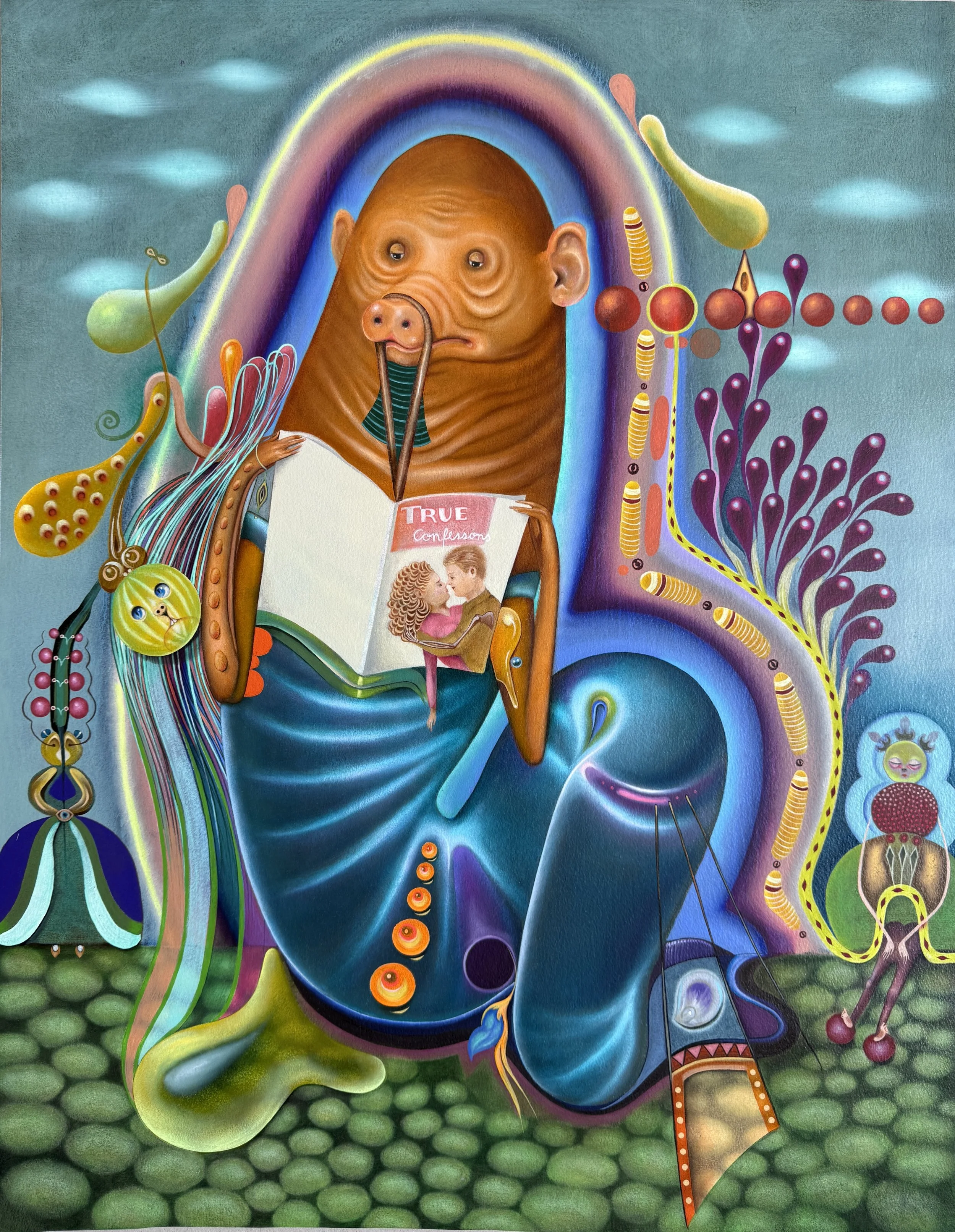Myths, Dreams and New Realities
Friday, January 9 to Saturday, February 28, 2026
Opening: Thursday, January 8 at 7 pm
Group exhibition with works by women artists who use surreal aspects in their practices.
Participating artists: Wanda Stang, Jutta Scheiner, Mirja Gastaldi, Manita Kaewsomnuk, Olivia Berger and Nena Cermak
Many have believed that surrealism was dead. Many wrote so. Childish nonsense: its activity extends today to the entire world and surrealism remains livelier, more audacious than ever. Surrealism, which never for a single instant ceased to stand in service to the greatest emancipation of humankind, wanted to sum up the entirety of all its efforts in one magical word: freedom. (Suzanne Césaire)
Surrealism has always existed. The unconscious, dream-driven, automatic or trance-like creativity have always been part of human artistic expression. Works by Hieronymus Bosch, Giuseppe Arcimboldo and Symbolist painters such as Gustave Moreau and Odilon Redon bear witness to this. Even if it took Sigmund Freud and André Breton to give the unconscious – and thus the surreal – a name.
The feminine plays a central yet ambivalent role in surrealism. In the male-dominated movement of the early 20th century, women were often portrayed as muses, dream figures or symbols of the unconscious. They embodied the mysterious, the erotic and the irrational – all those qualities that the Surrealists sought in their rejection of rational order. The feminine became a projection screen for male fantasies.
And yet it was and is precisely female artists who independently developed the surreal perspective. Leonor Fini, Jane Graverol, Rachel Baes and Unica Zürn broke with the role of the passive muse and created works that focus on female subjectivity, magic and transformation. Their surrealism is often more introspective and deals with themes such as identity, the body, sexuality and the relationship with nature.
As Suzanne Césaire put it in her 1946 text Le Grand Camouflage, the feminine in surrealism is an expression of a deep search for self-determination.
The six female artists shown in this exhibition take up a wide variety of surreal aspects in their respective artistic practices, thus emphasising the continuing relevance of surrealist thinking – perhaps especially in our times.
Jutta Scheiner, Apophis, 2025, 65x50cm, Oil on Paper
Bios
Wanda Stang lives and works in Berlin. She studied painting, master student at the Weissensee Academy of Art in textile and surface design. Artistic assistant and designer for Alexander McQueen, London. Lives and works in Berlin. Member of the Berlin art association ‘FOYOU’. Wanda Stang is an artist with an unconventional approach to art. Her works have the ability to transcend traditional boundaries and speak to viewers on a deep level. Her unique perspective and dedication to her craft make her a striking personality in contemporary art.
Jutta Scheiner, born in Sibiu, Romania (Transylvania), lives and works in Berlin, Germany. She trained in ivory carving and studied sculpture at the Kunsthochschule Berlin-Weißensee. Her work includes painting and collage. The interior is complex, raw, contradictory. Comprehensibility requires a form, an order that tames the chaotic. How much of the interior fits into a form without losing itself?
Mirja Gastaldi was born in Berlin, has lived for years in Antibes, France, and since 2018 again in Berlin. Master of Fine Arts at UdK Berlin in 2004. Mirja explores figurative storytelling in her paintings, drawings and objects. Dreamlike and mythical imagery conveys human fragility and the ups and downs of life. As if in a playact, characters appear in all their loneliness and co-dependency. The canvas remains unstretched and is reminiscent of a tapestry.
Manita Kaewsomnuk, is a Thai artist currently based in Berlin. She is working mainly in drawing and painting. Having been born and raised in a family of artist, arts naturally grew as her main passion. She graduated from Silpakorn University, Thailand, in program of Visual Communication Design. In her practices, it starts out with the individual perspectives, then integrate human sensation with social and cultural context. Her distinctive painting is displayed female figures, to denote different aspects of human beings. Manita’s artwork has been shown in solo and group exhibitions in Bangkok and Germany since 2018.
Nena Čermák wants to open new artistic worlds, bring about social change, and create freedom. Nena Čermák analyses the interaction of different forms and dimensions of intersectionality, diversity, and interculturality in an integrative way and further expands these dimensions by developing new forms of existence that arise across species between humans, animals, machines, and plants. She translates her multidimensional perspective using different materials and approaches that are haptically inviting, as she uses textiles for her sculptures, develops immersive interdisciplinary installations that involve the recipient, and creates images that bear her distinctive signature. Her work makes it clear that there must be new and different intensities and scope for diversity that advocate for commonality, loyalty, and equality. She lives and works in Munich.
Olivia Berger grew up on Mauritius Island and is based in Berlin since 2010. Olivia is a self-taught artist and painter. She mostly paints with oil but also uses other materials like graphite and ink for detailed and realistic drawings. The philosophy of her art can be described as a trinity of People, Colors and Geometry. She credits her position between both a German and Mauritian identity as nourishing her creativity and curiosity in the world. However, growing up with the polarity of two cultural backgrounds which can be seen in her artworks; lent itself to a lonely existence, whereby she questioned her belonging to each culture and in doing so, felt a lack of belonging altogether. “I am not white, nor am I black – I am simultaneously the existence of both.”

